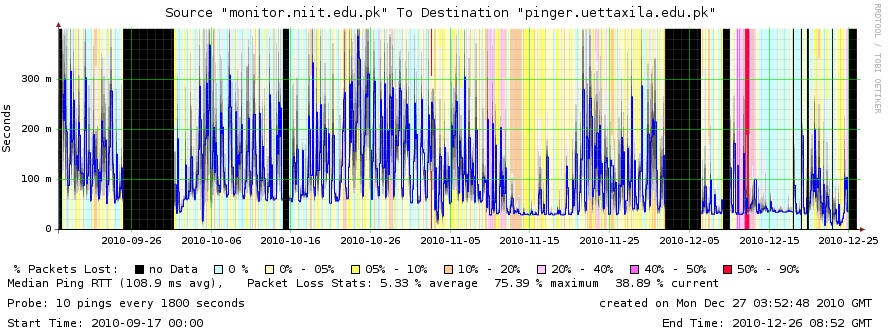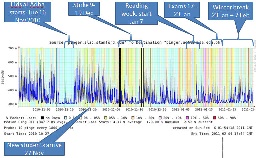...
As reported in the Sep-Oct 2010 HEC report, path from SEECS to UET Taxila is seeing high round trip times.
Analysis
Looking at the pingtable.pl data from SEECS to UETTaxila results for September and October one sees:
...
Linux 2.4 and later versions implemented a sender-side autotuning mechanism, so that setting the optimal buffer size on the sender is not needed (see here). This assumes you have set large buffers on the receive side, as the sending buffer will not grow beyond the size of the receive buffer.unmigrated-wiki-markup
There is an interesting \ [discussion on the effects of buffering on [RTTs|http://gettys.wordpress.com/2010/12/03/introducing-the-criminal-mastermind-bufferbloat/].
The poor reachability of UETTAXILA makes the problem harder to diagnose.
...
Analysis for Jan 14 to Jan 27 didn't reveal any patterns apart from heavy network utilization from midnight to 4am (Pakistan Daylight Time) in the morning. Possible reason could be data transfer between NCP and UETTAXILA. This is part of their research collaboration. Below is the strip graph from Jan 14 to Jan 27. Spreadsheet attached here.
Activity details
<snip>The details are:
- Fresh batch came in on 27th Nov
- Strike was on 9th Dec
- The university was shut down 9-19 Dec
- University was back on schedule 20th Dec 2010
- Holidays (Reading week) started 7th Jan
- Exams 17-23 Jan
- Winter break 23rd Jan - 7th Feb
...
|
|---|
The Smokeping plot from SLAC to UETTaxila for this period with associated events (powerpoint ) |
Misc:
- Available bandwidth: 16 Mbps.
- Throttled to 8Mbps --- for unknown reasons.
- All multimedia access (e.g., youtube) is blocked
- During daytime until 3:30pm when the classes are on, internet access is blocked to the hostels. After 3:30pm it is enabled thus RTT increases.
Bandwidth distributed between 5 buildings. (CS is consuming 4Mbps at the moment, while the other departments share the rest). 1.
- Electrical and Electronics
...
- Mechanical and Mechatronics
...
- T&IE (CS & Telecomm.)
...
- Civil and Transportation
...
- Administration block
In addition to access control (using ACLs) each user's browsing activity is logged. <snip>
The details are:
- Fresh batch came in on 27th Nov
- Strike was on 9th Dec
- The university was shut down 9-19 Dec
- University was back on schedule 20th Dec 2010
- Holidays (Reading week) started 7th Jan
- Exams 17-23 Jan
- Winter break 23rd Jan - 7th Feb
Misc:
- Available bandwidth: 16 Mbps.
- Throttled to 8Mbps --- for unknown reasons.
- All multimedia access (e.g., youtube) is blocked
Bandwidth distributed between 5 buildings. (CS is consuming 4Mbps at the moment, while the other departments share the rest).
- Electrical and Electronics
- Mechanical and Mechatronics
- T&IE (CS & Telecomm.)
- Civil and Transportation
- Administration block
...
Analysis from the above data and activity details
...
Our set of analyzed dates consists of 24th to 30th December and then from 4th Jan to 27th Jan.
24th to 30th December was when university was back to normal routine after strike holidays. In that case, the analysis is at the correct data. The important observations at this data were that high RTTs were observed from 12am to 4am and at 10am to 1pm PST (PST= GMT + 5). This is the second last week before final exams and students are busy in final projects and submissions because of which network utilization is expected to be high. During daytime until 3:30pm PST when the classes are on, internet access is blocked to the hostels. After 3:30pm PST it is enabled in the hostels as well which results in an increased number of users. An increase in RTT is therefore observed at times around 5.30 pm PST (12.30 pm GMT) and remains so till early morning of the following day. This can be seen in the hourly graph shown below.
|
From 7th Jan to 17th Jan there were pre-exam holidays. From 7th to 13th Jan average RTT was higher than previous days of 4th Jan to 6th Jan. This is because of students using internet for multiple purposes in their holidays. This might include social networking when youtube is blocked. From 14th Jan onwards high average RTTs are observed after midnight till early morning. This is possibly because students have now started preparing for exams and they study at night.
Normal RTT behavior was observed on 24th and 25th Jan, however, high RTT after midnight were again observed on 26th and 27th Jan. This might be because of project submissions deadlines approaching and students working on their research projects after taking 2-3 days off after exams.
A reason for high average RTT for UETTAXILA can be the low bandwidth allocation. As mentioned, 4MB of bandwidth is shared among 4 departments. This increases the load on network and results in congestion, long queues, hence large RTTIn addition to access control (using ACLs) each user's browsing activity is logged.

